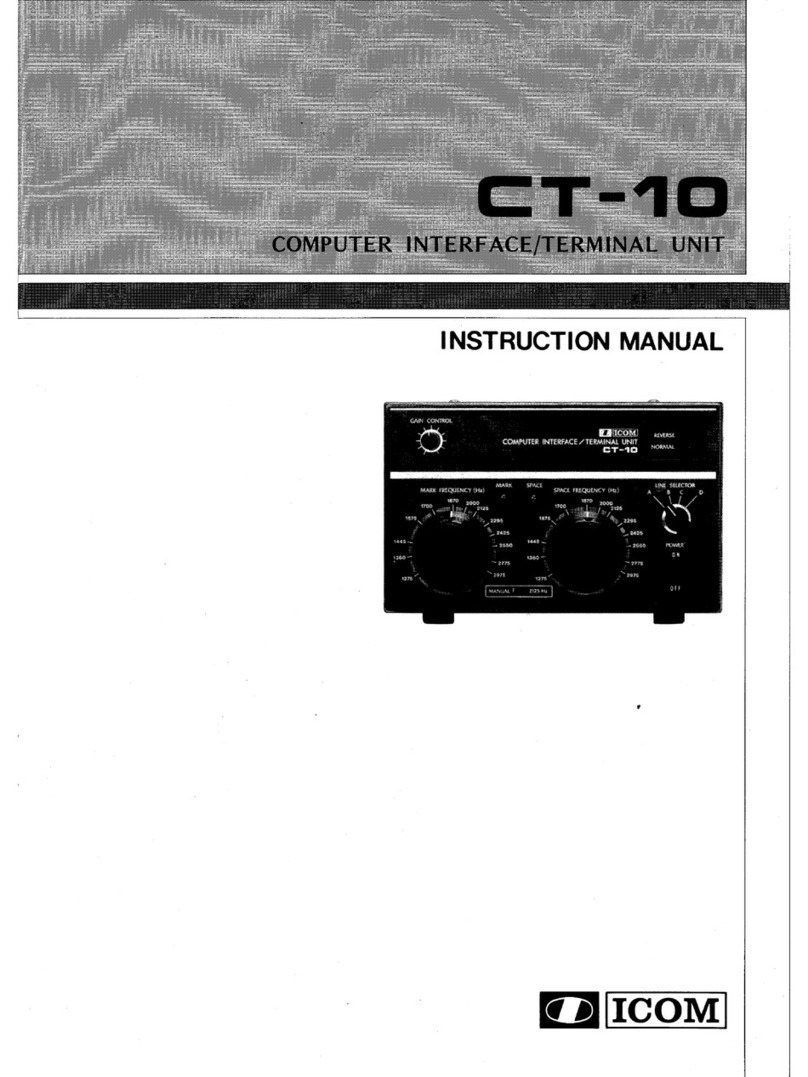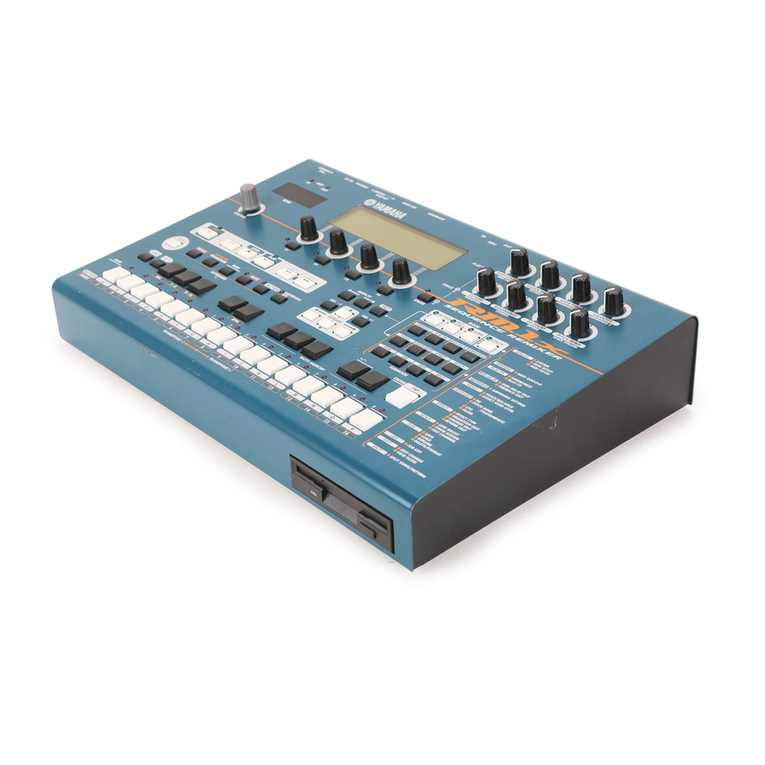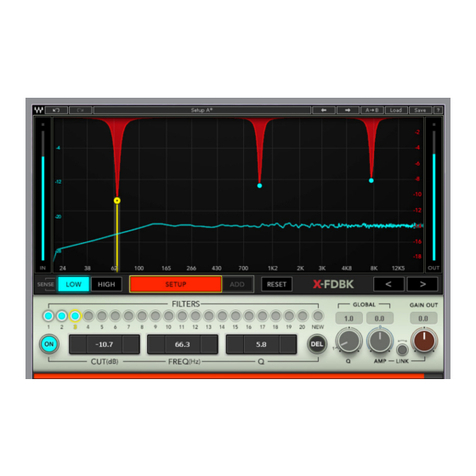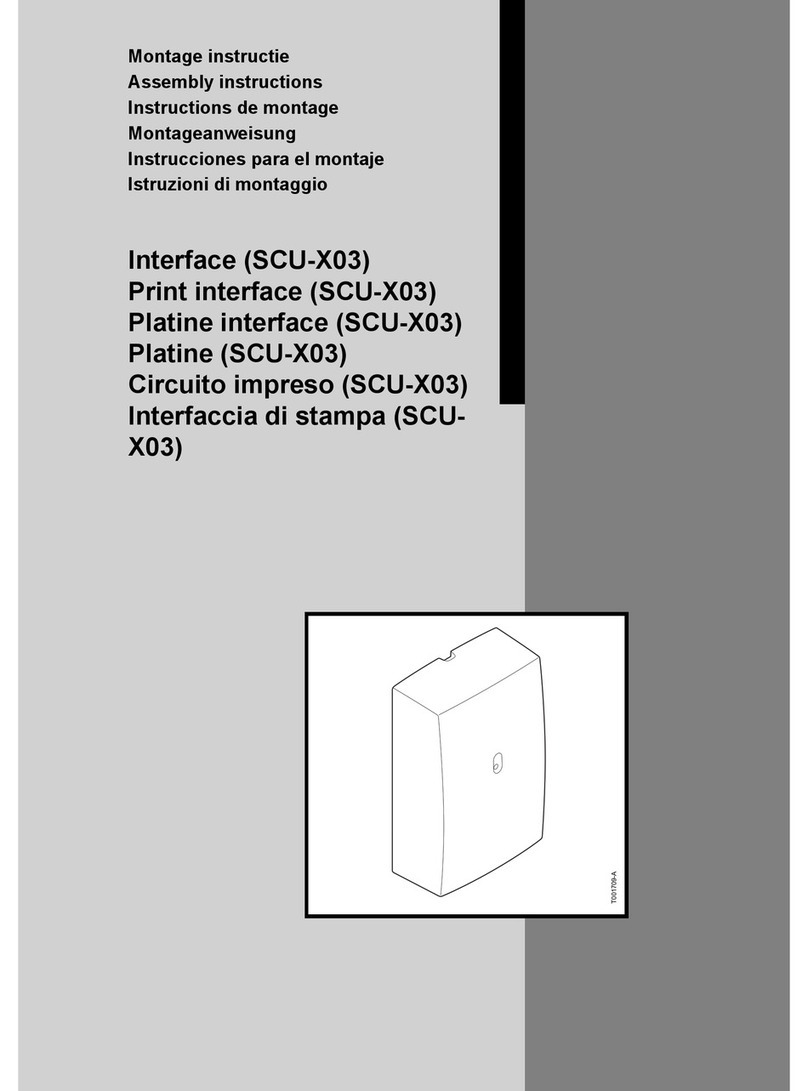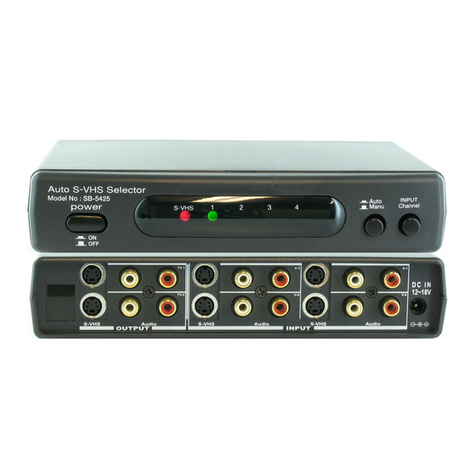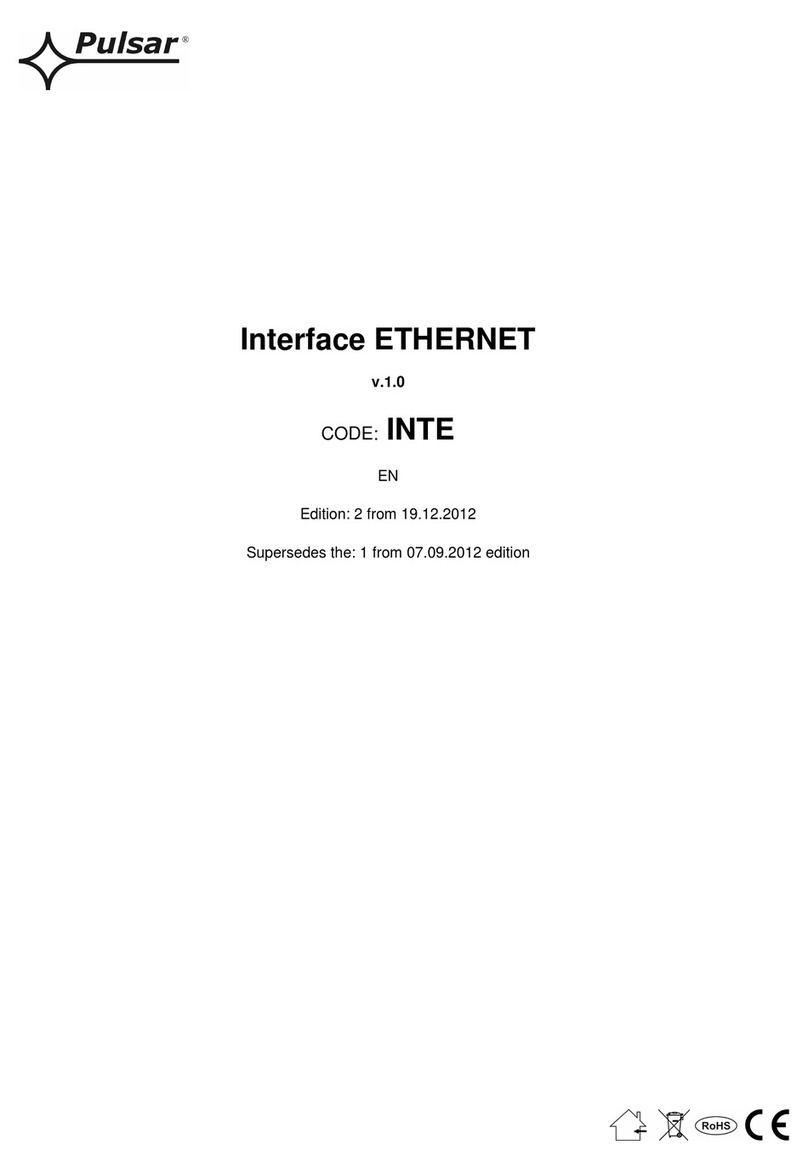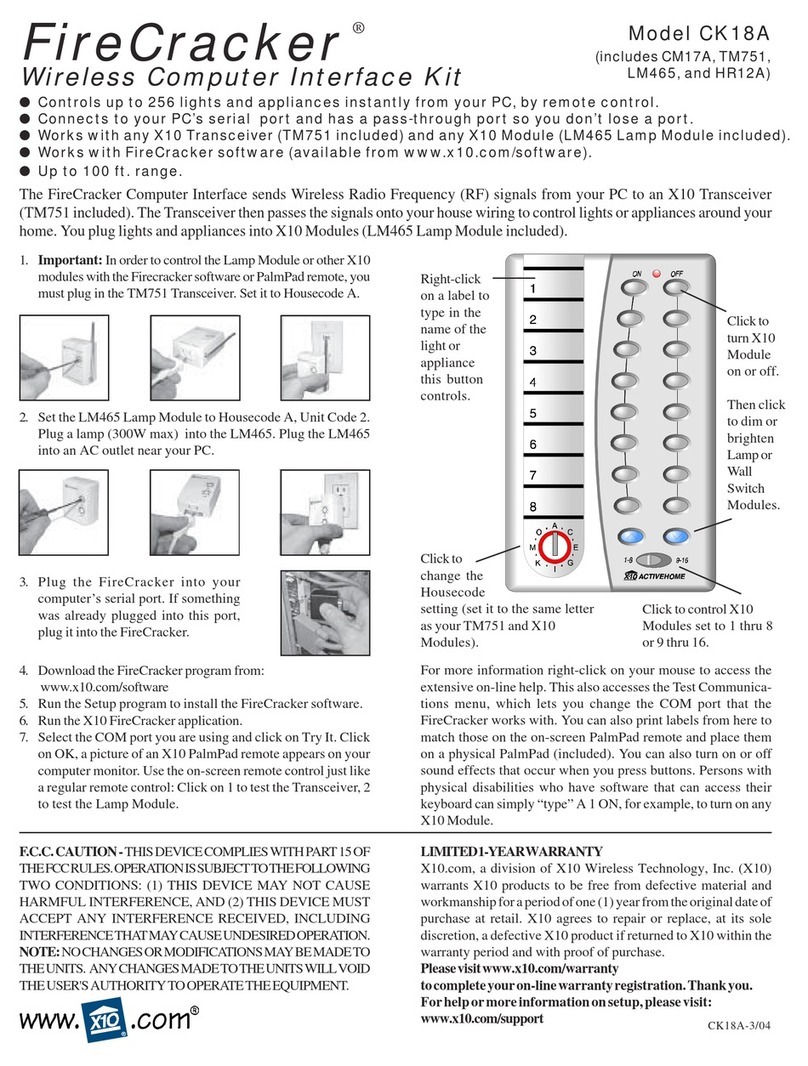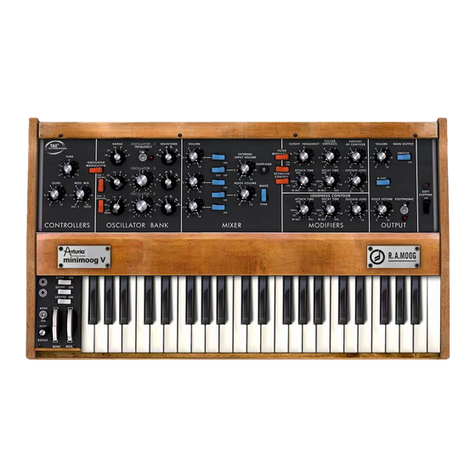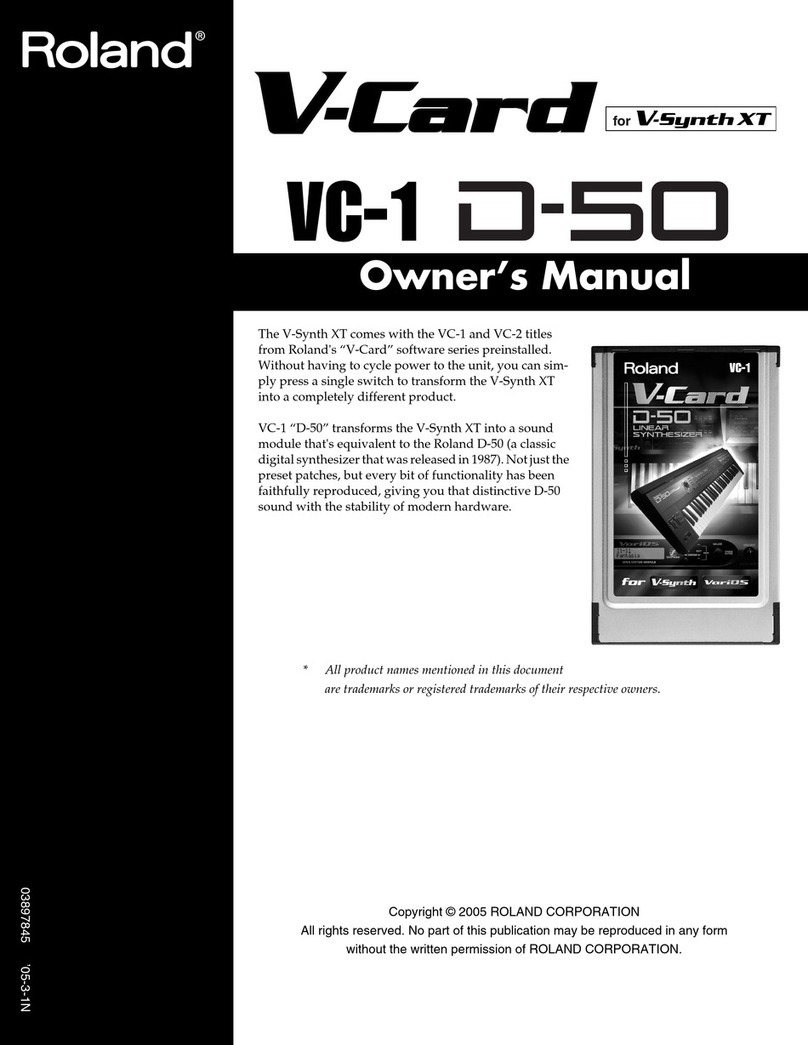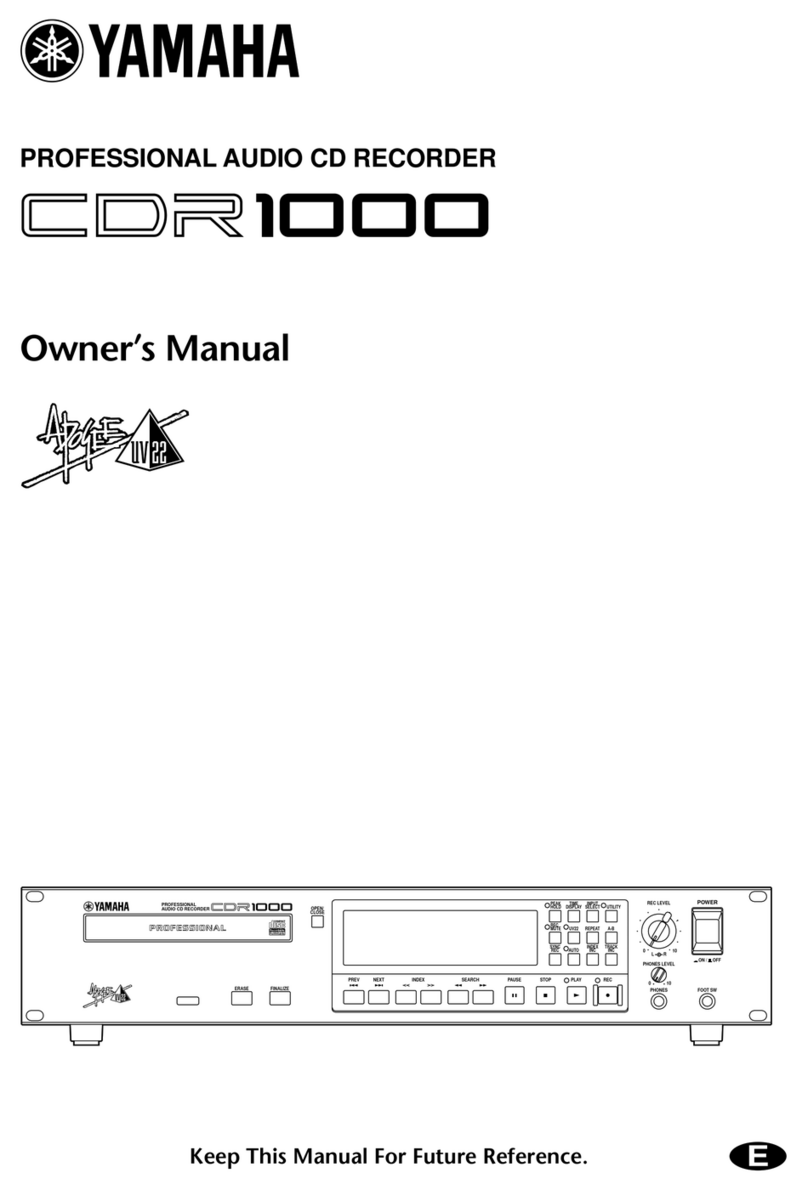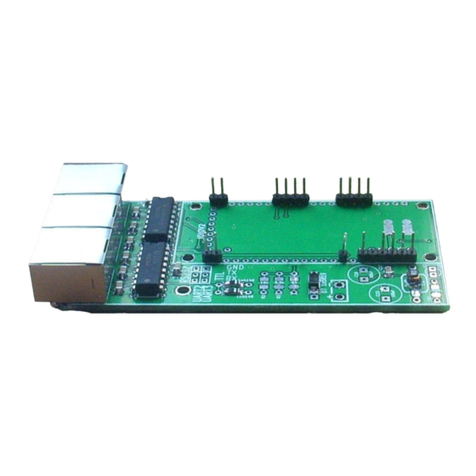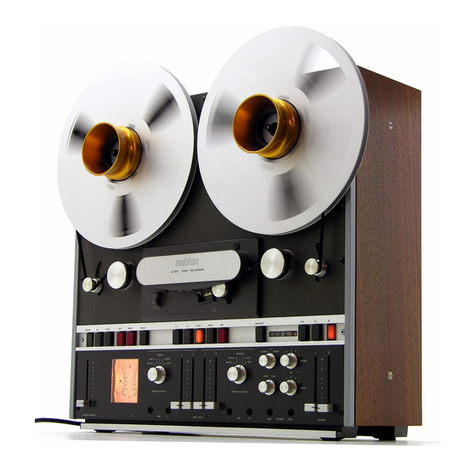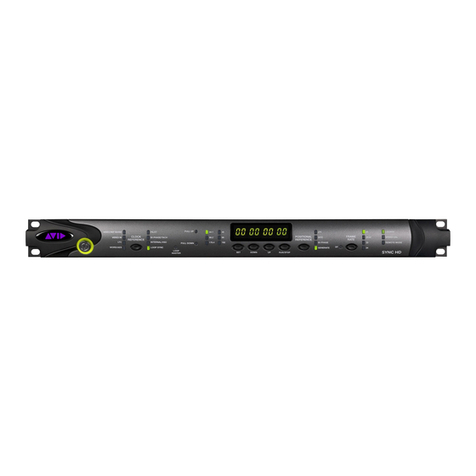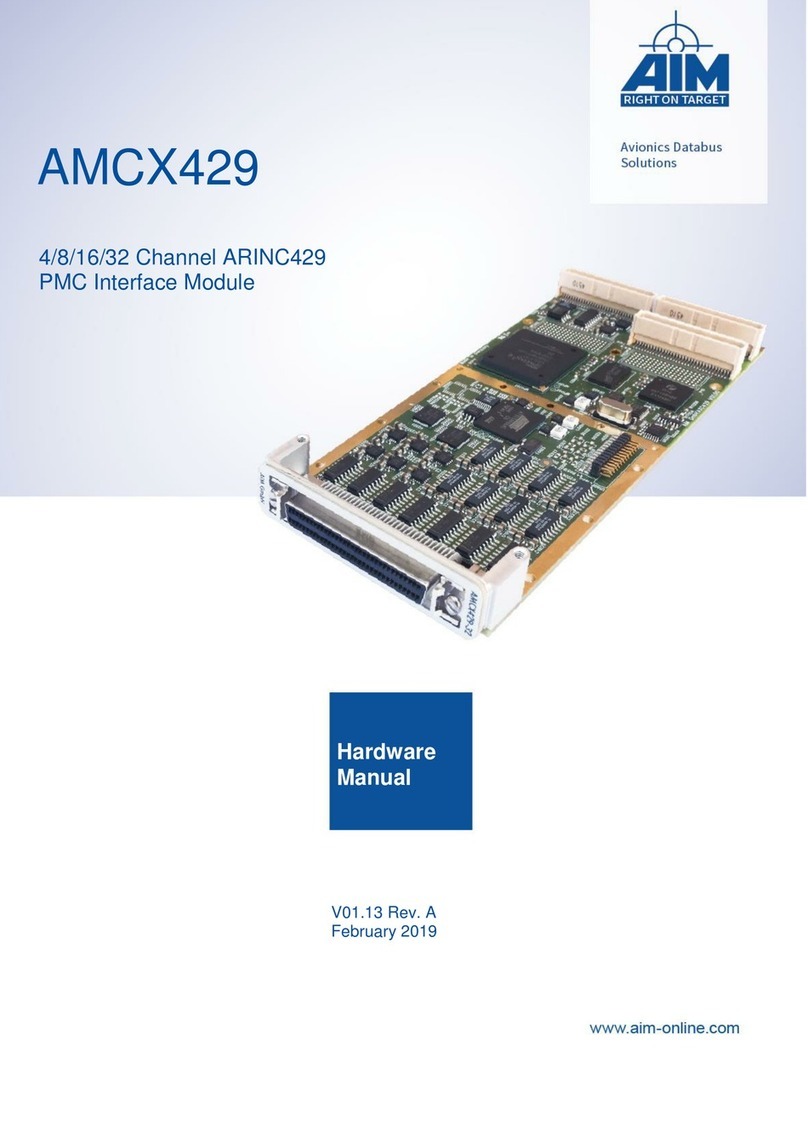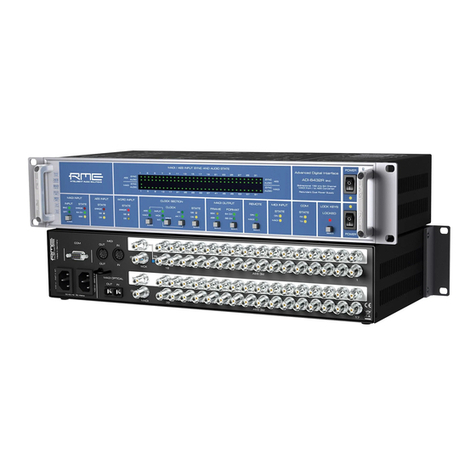Icom DS-100 (#02) User manual

offered by Busse-Yachtshop.com
DS-100
DSC CONTROLLER
(#02)
INSTRUCTION MANUAL
DS-100#02-(2) 01.12.13 10:53 AM Page 33 (1,1)

offered by Busse-Yachtshop.com
i
FOREWORD
Thank you for purchasing this Icom product. The DS-100 (#02)
DSC CONTROLLER
is designed and built with Icom’s superior
technology and craftsmanship. With proper care this product
should provide you with years of trouble-free operation.
IMPORTANT
READ ALL INSTRUCTIONS carefully and com-
pletely before using the controller.
SAVE THIS INSTRUCTION MANUAL—This in-
struction manual contains important operating instructions for
the DS-100.
EXPLICIT DEFINITIONS
FEATURES
☞Class D DSC terminal
The DS-100 (#02)
VHF DSC CONTROLLER
is designed as
a ‘Class D DSC terminal unit’ for the IC-M401EURO or
IC-M503
VHF MARINE TRANSCEIVERS
.
DS-100 (#02) is not compatible with DS-100 (#01). The
plug of the control cable is a different type.
☞Self ID indication
THE MMSI NUMBER SHOULD BE PROGRAMMED BY
A DEALER PRIOR TO INSTALLATION.
The DS-100 (#02) does not function when there is no ID
programmed. Therefore, the ID code should be checked
in the Set-up menu.
WORD DEFINITION
RWARNING Personal injury, fire hazard or electric
shock may occur.
CAUTION Equipment damage may occur.
NOTE If disregarded, inconvenience only. No risk
of personal injury, fire or electric shock.
Icom, Icom Inc. and the logo are registered trademarks of
Icom Incorporated (Japan) in the United states, the United King-
dom, Germany, France, Spain, Russia and/or other countries.
DS-100#02-(2) 01.12.13 10:53 AM Page ii (1,1)

offered by Busse-Yachtshop.com
ii
CE Versions of the DS-100 which display the “CE”
symbol on the serial number seal, comply with the
essential requirements of the European Radio and
Telecommunication Terminal Directive 1999/5/EC.
This warning symbol indicates that this equipment
operates in non-harmonised frequency bands and/or
may be subject to licensing conditions in the country
of use. Be sure to check that you have the correct
version of this radio, or the correct programming for
this radio, to comply with national licensing require-
ments.
RWARNING! NEVER connect the controller to an AC
outlet. This may pose a fire hazard or result in an electric
shock.
RWARNING NEVER transmit a distress call when
your vessel does not need immediate help. Distress calls can
be used only in times of emergency.
NEVER connect the controller to a power source of more
than 16 V DC. Such a connection will ruin the controller.
NEVER place the controller where normal operation of the
ship may be hindered or where it could cause bodily injury.
AVOID using or placing the controller in direct sunlight or in
areas with temperatures below –20°C (–4°F) or above +60°C
(+140°F).
KEEP the controller out of the reach of children.
KEEP the antenna cable and DC power cable as far away
as possible from electrical pumps, generators and other elec-
tronic instruments to prevent instrument malfunctions.
KEEP the controller and microphone at least 1 meter away
from your vessel’s magnetic navigation compass.
DO NOT use chemical agents such as benzene or alcohol
when cleaning, as they can damage the terminal unit sur-
faces.
CAUTIONS
DS-100#02-(2) 01.12.13 10:53 AM Page iii (1,1)

offered by Busse-Yachtshop.com
iii
FOREWORD ........................................................................ i
IMPORTANT ........................................................................ i
EXPLICIT DEFINITIONS ...................................................... i
FEATURES .......................................................................... i
WARNING ............................................................................ i
CAUTIONS .......................................................................... ii
TABLE OF CONTENTS ...................................................... iii
1 PANEL DESCRIPTION .............................................. 1-2
■Front panel ................................................................. 1
■Function display ......................................................... 2
2 CALL PROCEDURE ................................................. 3–8
■Entry an MMSI ........................................................... 3
■Distress call/Simple operation ...................................... 4
■Distress call/Regular operation ..................................... 5
■Entry Position/Time .................................................... 6
■Distress call to ships .................................................. 7
■Individual call ............................................................. 7
■Group call .................................................................. 8
■All ships call ............................................................... 8
3 WHEN RECEIVING A DSC CALL ........................ 10–17
■When receive a distress call .................................... 10
■Received message .................................................. 14
4 SET-UP ................................................................. 18–20
■Select ‘Set-up’ .......................................................... 18
TABLE OF CONTENTS
■Address ID ............................................................... 18
■Offset time ............................................................... 20
■Brightness ................................................................ 20
■Contrast ................................................................... 20
■MMSI check ............................................................. 20
5 CONNECTIONS AND INSTALLATION ................ 21–23
■Connection diagram ................................................. 21
■Rear panel description ............................................. 22
■Supplied accessories ............................................... 22
■Mounting .................................................................. 23
6 VHF MARINE CHANNEL LIST ................................... 24
7 SPECIFICATIONS AND OPTIONS ............................. 25
■Specifications ........................................................... 25
■Options .................................................................... 25
8 DIMENSIONS .............................................................. 26
9 MB-75 (OPTION) ................................................... 27-28
■MB-75 FLUSH MOUNT KIT ..................................... 27
10 TEMPLATE ................................................................. 29
11 DOC ............................................................................ 31
DS-100#02-(2) 01.12.13 10:53 AM Page iv (1,1)

offered by Busse-Yachtshop.com
1
1
PANEL DESCRIPTION
■Front panel
qDISTRESS BUTTON
Push and hold for 5 sec. to make a distress call.
wCLEAR SWITCH [CLR]
➥Push this key to cancel Call repeat.
➥Push this key to cancel the menu.
eCALL SWITCH [CALL]
➥Push this key to call up a subject menu screen.
➥Push the key to return to the start screen.
rENTER [ENT]
➥Enters the selected subject and advances the item to in-
dicate the contents.
➥Push this key to determine the data.
tUP/DOWN/LEFT/RIGHT SWITCHES [Y]/[Z]/[ΩΩ]/[≈≈]
➥Push [Y]/[Z] to select the menu contents in the selected
item.
➥Push [Y]/[Z] to adjust brightness and contrast.
➥Push [Ω]/[≈] to move the cursor position.
yKEYPAD
➥Input the corresponding number or letters when re-
quired.
➥Other functions are as follows;
[A/a]–Push this key to toggle between capital letters,
small letters or numerals. ‘A; capital letter’ or ‘a;
small letter’ appears in the upper right of the display,
depending on selection.
[BS]–Backspace key.
uFUNCTION DISPLAY
During normal operation the display shows position and
UTC (or Local) time when a GPS receiver is connected.
This is updated each time new GPS data is received.
If no GPS receiver is connected, the position and UTC time
must be set in advance.
CLR CALL ENT
WATER RESISTANT
1
QZ
3
DEF
2
ABC
4
GHI
6
MNO
5
JKL
7
PRS
9
WXY
8
TUV
A/a
BS
0
-
/ ,
DISTRESS
DSC CONTROLLER ds-100
qwer t
y
u
DS-100#02-(2) 01.12.13 10:53 AM Page 1 (1,1)

offered by Busse-Yachtshop.com
2
1PANEL DESCRIPTION
NOTE: If GPS data is interrupted for 30 sec. the “GPS” indi-
cation disappears. The terminal unit retains the most recent
data in such cases.
■Function display
qGPS INDICATOR
➥“GPS” appears while GPS receiver is connected.
➥“GPS’ disappears when no GPS receiver is connected.
➥“MNL’ appears when the time data and position data are
input manually.
wTIME ZONE INDICATOR
➥“Local” appears when the offset time data in the ‘Set-up’
menu is entered.
➥“No time data’ appears when no GPS receiver is con-
nected and no time data is input manually.
ePOSITION INDICATOR
➥Shows the GPS position data.
• “??” may blink every 2 sec. instead of position data, when
the GPS position data is invalid. In such a case, the last
position data is held for up to 23.5 hours.
➥Shows the manually input position data when no GPS re-
ceiver is connected. “MNL” appears instead of “GPS” at q.
• “??” may blink every 2 sec. instead of position data, 4
hours after the position data is input manually up until
23.5 hours have past.
➥“No position data” appears when no GPS receiver is con-
nected and no position data is input manually.
-VHF DSC CONTROLLER-
CH 70 WATCHING
GPS:UTC4:45
Lat4559'N
Lo 13444'E
w
q
e
NOTE: When no key operation is made for more than 5
minutes, the function display contents returns to the open-
ing menu message as shown at left, automatically.
DS-100#02-(2) 01.12.13 10:53 AM Page 2 (1,1)

offered by Busse-Yachtshop.com
2
CALL PROCEDURE
3
■Entring an MMSI
An ID code of your ship must be
entered before using the unit for
the first time. Only 3 selectable
subjects appear when your ID
code has not been entered yet.
No distress call can be transmit-
ted in the above condition.
DEntring an MMSI
qPush [CALL], then push [√]
to select ‘Set up’.
wPush [ENT], then push [Z]
several times to select
‘MMSI entry’, then push
[ENT] again.
eEnter the 9 (nine) digit ID
code.
rPush [POWER] on the con-
nected transceiver to turn the
power OFF.
tPush [POWER] to turn the
power ON again. All operat-
ing items/functions can be
selected and use from now
on.
<Select a subject>
Entry position/time
Received calls
≈Set up
<Select a subject>
Brightness
Contrast
MMSI check
≈MMSI entry
<CLR Exit / ENT OK>
<Entry a MMSI >
ID:(9digit)
_____________
Turn power OFF once,
then turn it ON again
DS-100#02-(2) 01.12.13 10:53 AM Page 3 (1,1)

offered by Busse-Yachtshop.com
CALL PROCEDURE
2
4
■Distress call/Simple operation
A distress call should be transmitted if, in the opinion of the
Master, the ship or a person is in distress and requires imme-
diate assistance.
A distress call should include the ship’s position and time.
They are included automatically when a GPS receiver is con-
nected. If no GPS is connected, input them, if possible.
NEVER: USE THE DISTRESS CALL WHEN
YOUR SHIP IS NOT IN AN EMERGENCY.
DISTRESS CALL CAN BE USED ONLY WHEN
IMMEDIATE HELP IS NEEDED.
qConfirm any distress call is
not being received.
wLift up the switch cover. Push
and hold the [DISTRESS]
button for 5 sec. to transmit
the distress call.
• A DSC channel (Ch 70) is auto-
matically selected and the dis-
tress call is transmitted.
• If you have the time, select the
nature of the distress and contents.
• If no GPS is connected, your location and UTC time should be
input.
eAfter transmitting the call, the transceiver is set to the
phone frequency (Ch 16) automatically.
• The controller is still waiting on
Ch 70 for an acknowledgment
call.
rWhen receiving the acknowl-
edgment, reply to the con-
nected station via the
transceiver’s microphone as
described on the page at
right.
NOTE:
• Distress alert (simple operation) contains (default);
Kind of distress: Undesignated distress
Position data: According to the displayed information.
- GPS or manual input position data held for 23.5 hrs.
• Distress call repeats every 3.5–4.5 min., until receiving an ‘ac-
knowledgement’
• Beep (Pi,Pi) sounds with the max. volume every 1 sec.
• Push [DISTRESS] button to transmit a renewed distress call, if de-
sired.
• Push [CLR] to cancel the ‘Call repeat’ mode.
The ‘cancel acknowledgement’ is automatically transmitted
when the [CLR] key is pushed.
<Push and hold
[DISTRESS] for 5 sec>
Nature of distress:
Undesignated
GPS : UTC 15:22
12°34’N
123°45’W
Distress alert
Completed
Now waiting for
acknowledgment
<CLR→Exit>
DS-100#02-(2) 01.12.13 10:53 AM Page 4 (1,1)

offered by Busse-Yachtshop.com
2
CALL PROCEDURE
5
■Distress call/Regular operation
Transmit a distress call after selecting the ‘Distress setting’.
NEVER: USE THE DISTRESS CALL WHEN
YOUR SHIP IS NOT IN AN EMERGENCY.
DISTRESS CALL CAN BE USED ONLY WHEN
IMMEDIATE HELP IS NEEDED.
qPush [CALL], then push [√]
several times to select ‘Dis-
tress setting’.
wPush [ENT] to select <Select
a nature>. Push [√] several
times to select the desired
nature, then push [ENT].
• Push [CLR] to Exit the menu.
eConfirm the location data,
then push [ENT] to confirm the time data.
rConfirm the UTC time, then push [ENT] to confirm the time
data.
• If no GPS is connected, your location and UTC time should be
input.
tLift up the [DISTRESS] switch cover. Push and hold the
button for 5 sec. to transmit
the distress call.
• A DSC channel (Ch 70) is auto-
matically selected and the dis-
tress call is transmitted.
• If no GPS is connected, your lo-
cation and UTC time should be
input.
yAfter transmitting the call, the
transceiver is set to the voice
calling channel (Ch 16) auto-
matically.
• The controller is still waiting for
an acknowledgment call on Ch
70.
uWhen receiving the acknowl-
edgment, reply to the con-
nected station via the
transceiver’s microphone as
described on page 8.
<Select a subject>
Entry position/time
Individual call
Group call
All ships call
Received calls
≈Distress setting
<Select a nature>
Undesignated
Fire,Explosion
Flooding
Collision
Grounding
Capsizing
≈Sinking
Disable adrift
Abandoning ship
Piracy attack
Man overboard
EPIRB emission
<Push and hold
[DISTRESS] for 5 sec>
Nature of distress:
Abandoning ship
GPS : UTC 15:22
12.34’N
123.45’W
DS-100#02-(2) 01.12.13 10:53 AM Page 5 (1,1)

offered by Busse-Yachtshop.com
CALL PROCEDURE
2
6
NOTE:
• ‘nature of distress’ will be valid for 10 min. until a distress
call transmits. After 10 min. it reverts to an undesignated dis-
tress.
• Distress call repeats every 3.5–4.5 min., until receiving an
‘acknowledgement’
• Beep (Pi,Pi) sounds with the max. volume every 1 sec. until
acknowledgement is received.
• Push clear to cancel a distress call prior to receiving and an
acknowledgement.
The ‘cancel acknowledgement’ is automatically transmitted when
the [CLR] key is pushed.
■Entry Position/Time
When no GPS receiver is connected, the ‘Entry
Position/Time’ appears at the top of the subject menu.
qPush [CALL], then push [√] to select ‘Entry Position/Time’.
wPush [ENT], then enter the latitude data with the key pad.
ePush [Y]/[Z] to select N; north latitude or S; south latitude,
then push [ENT].
• Push [Ω]/[≈] to move the cur-
sor then push [Y]/[Z] to correct
the data
• Push [CLR] to Exit the menu.
• Push [A/a], the push [ENT] to
enter ‘Null data’.
rEnter the longitude data with
the key pad.
tPush [Y]/[Z] to select E;
east longitude or W; west
longitude, then push [ENT].
• Push [Ω]/[≈] to move the cur-
sor then push [Y]/[Z] to correct
the data
• Push [CLR] to Exit the menu.
• Push [A/a], the push [ENT] to
enter ‘Null data’.
<Input a position>
Latitude
°’N
Longitude
°’E
<A/a Null data>
<CLR Exit / ENT OK>
<Input a Time>
UTC :
<A/a Null data>
<CLR Exit / ENT OK>
DS-100#02-(2) 01.12.13 10:53 AM Page 6 (1,1)

offered by Busse-Yachtshop.com
7
2
CALL PROCEDURE
yPush UTC time with the keypad.
• Push [Ω]/[≈] to move the cursor then push [Y]/[Z] to correct the
data
• Push [CLR] to Exit the menu.
• Push [A/a], then push [ENT] to enter ‘Null data’.
■Distress call to ships
General DSC calls may be used for communications after the
Distress call, e.g. you want to change the operating mode,
frequency, etc.
■Individual call
DIndividual call to the coast station
qPush [CALL], then push [√] several times to select ‘Indi-
vidual call’ then push [ENT].
wPush [√] several times to select the coast station ID ad-
dress. Then push [ENT].
(See page 18 for adding an address.)
eSelect the coast station ID.
ePush [CALL] and [ENT] simultaneously to transmit an Indi-
vidual call.
• Push [CLR] to stop the call.
r‘RCV Individual call—From: Coast stn’, appears on the
screen.
tPush [ENT] to transfer the instructed traffic channel*to the
transceiver.
* Traffic channel is determined by the coast station automatically.
DIndividual call to other ships
qPush [CALL], then push [√] several times to select ‘Indi-
vidual call’ then push [ENT].
wSelect ‘manual entry’ to enter
9 digit ID or push [√] to se-
lect the desired ID address.
Then push [ENT].
• ‘Select a traffic CH’ screen ap-
pears.
ePush [Y]/[Z] to select your
desired traffic channel from
the list. Then push [ENT].
rPush [CALL] and [ENT] si-
multaneously to transmit an
Individual call.
• Push [CLR] to stop the call.
<Input address ID>
ID:(9digit)
<CLR Exit / ENT OK>
<Select address ID>
≈Manual entry
DS-100 SN10
DS100 SN2
DS100 SN3
<CLR Exit / ENT OK>
DS-100#02-(2) 01.12.13 10:53 AM Page 7 (1,1)

offered by Busse-Yachtshop.com
CALL PROCEDURE
2
8
■Group call
qPush [CALL], then push [√]
one or more times to select
‘Group call’, then push
[ENT].
wSelect ‘manual entry’ to enter
8 digit ID or push [√] to se-
lect the desired ID address.
Then push [ENT].
• ‘Select a traffic CH’ screen ap-
pears.
ePush [Y]/[Z] to select your
desired traffic channel from
the list. Then push [ENT].
rPush [CALL] and [ENT] si-
multaneously to transmit an
Individual call.
• Push [CLR] to stop the call.
■All ships call
qPush [CALL], then push [√]
one or more times to select
‘All ships call’, then push
[ENT].
wSelect the desired category,
then push [ENT].
eTo select desired traffic
channel push [BS] twice and
enter channel number.*
rPush [CALL] and [ENT] simultaneously to transmit an All
ships call.
• Push [CLR] to stop the call.
* Traffic channel automatically defaults to channel 16.
<Select a group>
≈Manual entry
ICOM
<CLR Exit / ENT OK>
<Select a category>
Safety
≈Urgency
<CLR Exit / ENT OK>
<Input an address>
ID:(8digit)
0
<CLR Exit / ENT OK>
DS-100#02-(2) 01.12.13 10:53 AM Page 8 (1,1)

offered by Busse-Yachtshop.com
9
2
CALL PROCEDURE
DWhen no acknowledgement is received
When no acknowledgement is received the unit will beep
every one second. In this case, the controller automatically
transmits the distress call again every 3.5 to 4.5 minutes.
• A distress relay call may be received after several min-
utes from another ship if acknowledgement cannot be re-
ceived from a coast station directly.
CAUTION: DO NOT push [CLR] while waiting for an ac-
knowledgement, otherwise the distress call repeat will be
cancelled, and a distress acknowledgement is automati-
cally transmitted with your own MMSI.
Use the [CLR] key only when you want to cancel repeated
transmission.
DAfter receiving an acknowledgement call
The following should be commenced with your voice trans-
mission after receiving a distress acknowledgement from a
coast station (or another ship).
• “MAY DAY”
• “This is .........(your ship name)”
• The 9-digit identity AND the call sign (or other iden-
tification of the ship).
• The ship’s position if the DSC distress does not in-
clude it.
• The nature of the distress and assistance required.
• Any other information which might facilitate the res-
cue.
DS-100#02-(2) 01.12.13 10:53 AM Page 9 (1,1)

offered by Busse-Yachtshop.com
10
3WHEN RECEIVING A DSC CALL
■When receiving a
Distress call
When receiving a distress call,
an alarm (Pi-po) sounds with
max. AF level continuously. And
at the same time, the trans-
ceiver’s (such as IC-
M401EURO or IC-M503)
operating channel changes to
CH 16 automatically.
• Push [CLR] to cancel the
alarm.
• Monitor the communication between the calling ship and
a coast station. When no communication is made, con-
tact the ship using voice transmission on CH 16.
—RCV Distress call—
Distress ID:
23456789
Distress time & pos
Time: UTC 12:34
Pos.: Lat 12°34’N
Lon 123°45’W
DS-100#02-(2) 01.12.13 10:53 AM Page 10 (1,1)

offered by Busse-Yachtshop.com
3
WHEN RECEIVING A DSC CALL
11
DWhen receiving an individual call
When receiving an individual
call, an alarm (Pi-pi) sounds.
• Push [ENT], then the oper-
ating channel changes to
the designated channel.
• Push [CLR] to record the
received information, then
the screen goes back to de-
fault.
• The calling station transmits via voice on the designated
channel.
• When the individual ACK function is available
When the individual acknowl-
edgement function is available
on your controller, push [ENT]
to turn to the <Select to com-
ply> screen.
• Select ‘Able to comply’ or
‘Unable to comply’.
• Emergency alarm (or con-
tinuous beeps depending
on the category) sounds until pushing [CLR].
<Select to comply>
≈Able to comply
Unable to comply
<CLR➝Exit/ ENT➝OK>
—RCV Individual call—
From: JOHN
<CLR➝Exit/ ENT➝OK>
DS-100#02-(2) 01.12.13 10:53 AM Page 11 (1,1)

offered by Busse-Yachtshop.com
12
3WHEN RECEIVING A DSC CALL
DWhen receiving an All ships call
• When receiving a Routine or
Safety all ships call, an alarm
(Pi-pi) sounds.
• When you receive a distress
or Urgency all ships call, an
alarm (Pi-po) sounds with
max. AF level continuously.
• Push [CLR] to cancel the
alarm.
• Push [ENT], then the oper-
ating channel changes to the received traffic channel au-
tomatically.
• Push [CLR] to record the received information, then the
screen goes back to default.
You must monitor the traffic frequency until you can judge
from the call that your action has been effective and/or assis-
tance is unnecessary.
DWhen receiving a Position request
When receiving a Position re-
quest call, an alarm (Pi-pi)
sounds.
• Push [ENT] to transmit your
own ships longitude and lat-
itude information.
• Push [CLR] to record the
received information, then
the screen goes back to de-
fault.
DWhen receiving a Position reply
When receiving a Position reply,
an alarm (Pi-pi) sounds.
• Push [CLR] to record the
received information, then
the screen goes back to de-
fault.
—RCV All ships call—
From: 23456789
Category: Routine
<CLR➝Exit/ ENT➝OK>
—RCV Pos request—
From: JOHN
To reply, push ENT
<CLR➝Exit/ ENT➝OK>
—RCV Pos reply—
From: Beck
Pos.: Lat 12°34’N
Lon 123°45’W
<CLR➝Exit>
DS-100#02-(2) 01.12.13 10:53 AM Page 12 (1,1)

offered by Busse-Yachtshop.com
3
WHEN RECEIVING A DSC CALL
13
DWhen receiving a Distress ACK
When receiving a distress ac-
knowledgement, an alarm (Pi-
po) sounds with max. AF level
continuously. And at the same
time, the transceiver’s (IC-
M503/M401EURO) operating
channel changes to CH 16 au-
tomatically.
• Push [CLR] to cancel the
alarm.
• You must monitor CH 16 until you can judge from the call
that your assistance is unnecessary.
DWhen receiving a Distress Relay ACK
When receiving a Distress
Relay acknowledgement, an
alarm (Pi-po) sounds with max.
AF level continuously. And at
the same time, the transceiver’s
(IC-M503/M401EURO) operat-
ing channel changes to CH 16
automatically.
• Push [CLR] to cancel the
alarm.
• You must monitor CH 16 until you can judge from the call
that your assistance is unnecessary.
DWhen receiving a group call
When receiving a Group call,
an alarm (Pi-pi) sounds.
• Push [ENT], then the oper-
ating channel changes to
the designated channel.
• Push [CLR] to record the
received information, then
the screen goes back to de-
fault.
• The calling station transmits
via voice on the designated channel.
—RCV Distress ACK—
From: Tokyo guard
Distress ID:
Mr.Bean
<CLR➝Exit/ ENT➝OK>
—RCV Group call—
From: D -100 N3
Group:Icom Inc
<CLR➝Exit/ ENT➝OK>
—RCV Distress RLY ACK—
From: Tokyo guard
Distress ID:
987654321
<CLR➝Exit/ ENT➝OK>
DS-100#02-(2) 01.12.13 10:53 AM Page 13 (1,1)

offered by Busse-Yachtshop.com
14
3WHEN RECEIVING A DSC CALL
■Received message (RCV MSG)
When receiving a DSC call, the received format is specified
and its contents are memorized into the received message
(RCV MSG) memory. Distress calls (including other calls with
distress category) are stored separately from other calls.
Up to 20 distress calls can be
memorized and up 20 other cat-
egories of calls can be memo-
rized. However, the distress
calls are saved until being
erased, while other calls are
erased when the power is
turned OFF.
DDistress message
qPush [CALL], then push [√]
one or more times to select
‘Received calls’, then push
[ENT].
wSelect a ‘Distress message’,
then push [ENT].
eSelect a desired message,
then push [ENT].
• Push [Y] or [Z] to scroll the
message.
• Push [A/a], then push [1] to
clear the message.
NOTE: The message number
that has not been read yet
blinks, e.g. .
3
<Select a message>
≈Distress message
Other message
<CLR Exit / ENT OK>
<Message contents>
Distress ID:
2345678
Piracy attack
Distress time & Pos
Time: UTC 12:34
Pos.: Lat 12°34’N
Lon 123°45’W
<A/a Data clear>
<Select a subject>
Entry Position/Time
Individual call
Group call
All ships call
≈Received calls
Distress setting
<Select a message>
≈1:Distress 12:21
2:Distress 11:21
3:Distress 10:21
4:Distress 09:21
<CLR Exit / ENT OK>
DS-100#02-(2) 01.12.13 10:53 AM Page 14 (1,1)

offered by Busse-Yachtshop.com
15
3
WHEN RECEIVING A DSC CALL
DOther messages
• Individual call
qPush [CALL], then push [√]
several times to select ‘Re-
ceived calls’, then push
[ENT].
wSelect ‘Other message’, then
push [ENT].
eSelect ‘Individual call’, then
push [ENT].
• Push [Y] or [Z] to scroll the
message.
• Push [A/a] to clear the mes-
sage.
• Group call
qPush [CALL], then push [√]
several times to select ‘Re-
ceived calls’, then push
[ENT].
wSelect ‘Other message’, then
push [ENT].
eSelect ‘Group call’, then
push [ENT].
• Push [Y] or [Z] to scroll the
message.
• Push [A/a] to clear the mes-
sage.
<Select a message>
1:Individual ACK
≈2:Individual call
3:Group call
4:All ships call
5:Distress
6:Distress relay
7:Distress RLY ACK
8:Distress ACK
<CLR Exit / ENT OK>
<Message contents>
Routine to group
From: Phil Collins
F3E/G3E simplex
CH78
No information
<Message contents>
Routine to Individual
From: DS-100 SN3
F3E/G3E simplex
CH88
No information
<A/a Data clear>
<Select a message>
1:Individual ACK
2:Individual call
≈3:Group call
4:All ships call
5:Distress
6:Distress relay
7:Distress RLY ACK
8:Distress ACK
<CLR Exit / ENT OK>
DS-100#02-(2) 01.12.13 10:53 AM Page 15 (1,1)

offered by Busse-Yachtshop.com
16
3WHEN RECEIVING A DSC CALL
• All ships
qPush [CALL], then push [√]
several times to select ‘Re-
ceived calls’, then push
[ENT].
wSelect ‘Other message’, then
push [ENT].
eSelect ‘All ships call’, then
push [ENT].
• Push [Y] or [Z] to scroll the
message.
• Push [A/a] to clear the message.
• Distress
qPush [CALL], then push [√]
several times to select ‘Re-
ceived calls’, then push
[ENT].
wSelect ‘Other message’, then
push [ENT].
eSelect ‘Distress’, then push
[ENT].
• Push [Y] or [Z] to scroll the
message.
• Push [A/a] to clear the mes-
sage.
• Distress relay
qPush [CALL], then push [√]
several times to select ‘Re-
ceived calls’, then push
[ENT].
wSelect ‘Other message’, then
push [ENT].
eSelect ‘Distress relay’, then
push [ENT].
• Push [Y] or [Z] to scroll the
message.
• Push [A/a] to clear the mes-
sage.
<Message contents>
Distress relay
From: Phil Collins
Distress ID:
2345678
To all ships
Fire,Explosion
Distress Time & Pos
Time: UTC 12:34
Pos.: Lat 12°34’N
Lon 123°45’W
<A/a Data clear>
<Message contents>
Routine to group
From: Phil Collins
F3E/G3E Simplex
CH88
No Information
<A/a Data clear>
<Message contents>
Urgency to All ships
From: DS-100 SN3
F3E/G3E simplex
CH 14
<A/a Data clear>
DS-100#02-(2) 01.12.13 10:53 AM Page 16 (1,1)
This manual suits for next models
1
Table of contents
Other Icom Recording Equipment manuals
